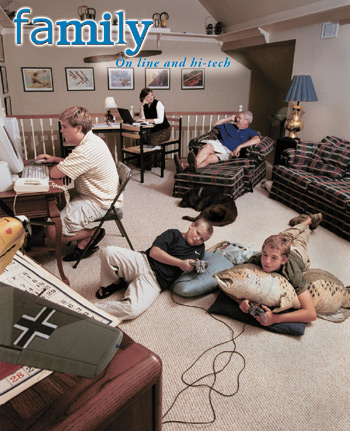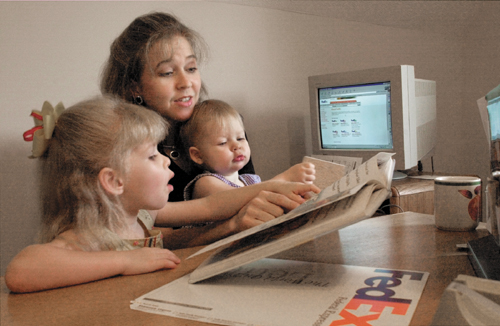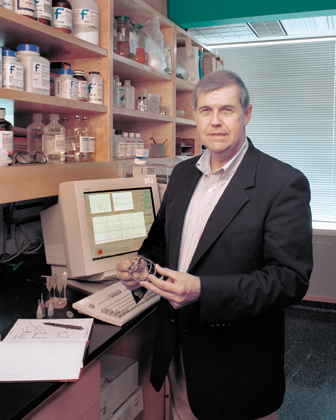|
by Sara Horn (shorn@uu.edu) Cell phones ring. Pagers beep. The quiet sounds of computer machinery whir in the background, and some-where a fax is coming in. What might be mistaken for an office setting is actually occurring within the home. Technology is all around, and the family has been affected in more ways than one might think. According to Dr. Naomi Larsen, department chair of sociology and social work at Union and associate professor of sociology, these new advances can be a blessing and a curse to today’s family – it’s all in how it’s being used. “Any technology – depending on how you use it – will prove to either be detrimental or beneficial for the family,” she says, adding that the key is balance. For example, Larsen notes, if a family is able to maintain a website that allows family members who live across the country to communicate and keep up with each other, then that use of technology is good. If overuse or abuse of cell phones, video games, and taking work home to finish on the family PC occurs, that says Larsen, does harm to the family, creating problems in communication and individual relation-ships. Telecommuting – the Best of Both Worlds?
Emily Dunn (’86), a software consultant for FedEx, was one of their first employees to telecommute from home. A full-time employee with the company’s Memphis office since 1988, Dunn says it was after she got married that the idea of telecommuting came up. “Since I had been there for so long and had so many projects I was involved with, it was decided that we’d try to telecommute from home (in Decatur, Tenn.) for six months,” recalls Dunn. She says that it worked so well, she was kept on in her full-time role. “I got so much more work done when I worked at home compared to working in the office,” says Dunn. “When I was on-site, I had meetings throughout the day and no one could reach me. When I telecommuted, I was always at my desk, so they could always reach me and I could also do my work faster because I had less interruptions.” Dunn worked full-time in that capacity until she and her husband Brian, who coaches Union’s women’s softball team, came to Union in 1996, where she taught computer science for two years. During that time, she acted as a part-time consultant for FedEx on the side. After her little girl was born, she resigned from the university to be a stay-at-home mom, but continues to work in consulting an average of 30 hours a week. Now mom to two little girls, Dunn says that advances in technology enable her to have computer access wherever she is. She says that advances particularly within communication technology have been very beneficial to what she does. With a cable modem dialing into the offices at FedEx, she says her response time on the computer is almost immediate – as quick as if she were actually sitting in the office. “There are a lot of benefits to telecommuting,” Dunn points out, “the most important being that I’m able to keep my kids home, so I get to see them a lot during the day.” Dunn does have someone who comes in to help with the children. “Unless the kids are asleep, I have a babysitter. Since I work with people all over the world, it’s very unprofessional for my 3-year old to be screaming ‘mommy, mommy’ while I’m on the phone,” says Dunn. Flexible hours are also a plus, she points out. “Telecommuting allows me to work very late at night, or very early in the morning – whatever works best for my schedule that day,” explains Dunn. “It’s wonderful that my kids are never far away from me.”
Adding Years to Your Life Dr. David Melvin (’64), a heart surgeon who now primarily conducts research at the University of Cincinnati, says that the most important development within cardiac medicine has been with safety. “Operations that we did 20 years ago can now be done much more safely,” says Melvin. “Nothing is ever routine, but we’ve now gotten to the point where we can offer people a chance to return to a normal life after a heart attack or experiencing some type of cardiac problem,” which has helped play a part in longer life expectancies. Heart transplants (as well as other organs) have come a long way, according to Melvin. “It’s come from being a total experimental procedure in the late seventies with a very fortunate person making it through the first year – to today allowing more than 90% to make it through the first year,” says Melvin. “The sobering thing is it’s such a limited number of people who benefit – more than 100,000 people need it annually, but only 2,000 – 3,000 actually receive one.” It is that troubling statistic that caused Melvin to go into more of a research role. “After running a heart transplant program, I got to the point where I said ‘there has to be something that can help more of these people,” explains Melvin, who left the transplant program he headed in 1990 to go back to engineering school. Though he still helps out on the occasional transplant, he currently is studying mechanical devices that can treat heart failure, similar to the new mechanical heart that recently replaced a critical patient’s own heart.
“That one that has just been put in is a very impressive device,” says Melvin, though he thinks there may be other ways that are potentially better. “The most important thing about the AbioCor heart is that it has solved several of the problems found in earlier attempts to make an artificial heart.” The most important advance, according to Melvin, is that by getting rid of the wires and tubes that go through the skin, there is a marked decrease in the chance of infection, and a great increase in the chance for a normal life. “Computers haven’t directly changed the heart operation itself,” remarks Melvin, “but it has dramatically improved the chance of making the right decision in individual cases. We have access to any type of information we want which, in turn, helps us better serve our patients.” It is the ability to take information normally found in 300- 500 page textbooks that doctors can now download to palm-size “personal digital assistants,” known as PDAs, that is just one of the advances revolutionizing the medical industry. According to Dr. Susan Jacob, a nursing professor and dean of Union’s School of Nursing, technology has greatly improved our way of life, specifically within the area of consumer education. “Now consumers and patients can access the Internet, find out as much about the disease, symptoms and medical options before they see the doctor, which also helps them know which questions to ask,” says Jacob. Practitioners also benefit from the Internet. The latest information is right at their fingertips. Before, says Jacob, it could take years for books to be published on a subject. “It’s really spurred communication and collaboration among nursing and healthcare professionals,” says Jacob, pointing out that telemedicine is also fast becoming a new way of practicing medicine. Telemedicine, or telehealth, allows a doctor in a rural community to per-form surgery with a specialist in another state or even country guiding the surgery through the use of video cameras and telecommunication. Cameras are also used in the homes of patients, allowing practitioners to monitor heart rates, and blood pres-sure among other things. With new developments occurring rapidly – such as new patient identification systems that prevent the wrong medicine being given to a patient – Jacob says it will be exciting to see where medicine will be in the next 50 years. What’s On the Web In… DESIGNING FAMILY WEBSITES... www.ourfamily.com • www.myfamily.comTHE FAMILY... www.crosswalk.com • www.parenting.com • www.igrandparents.com • Focus on the Family - www.family.orgKIDS... www.funbrain.com • Bill Nye the Science Guy - www.BillNye.com • Veggie Tales - www.bigidea.com , www.larry-boy.comTELECOMMUTING... - www.telecommute.org • www.homeworkingmom.comHEALTH... Center for Disease Control - www.cdc.gov • National Cancer Institute - www.nci.nih.gov •HealthFinder – www.healthfinder.gov • Healthtouch Online – www.healthtouch.com |



